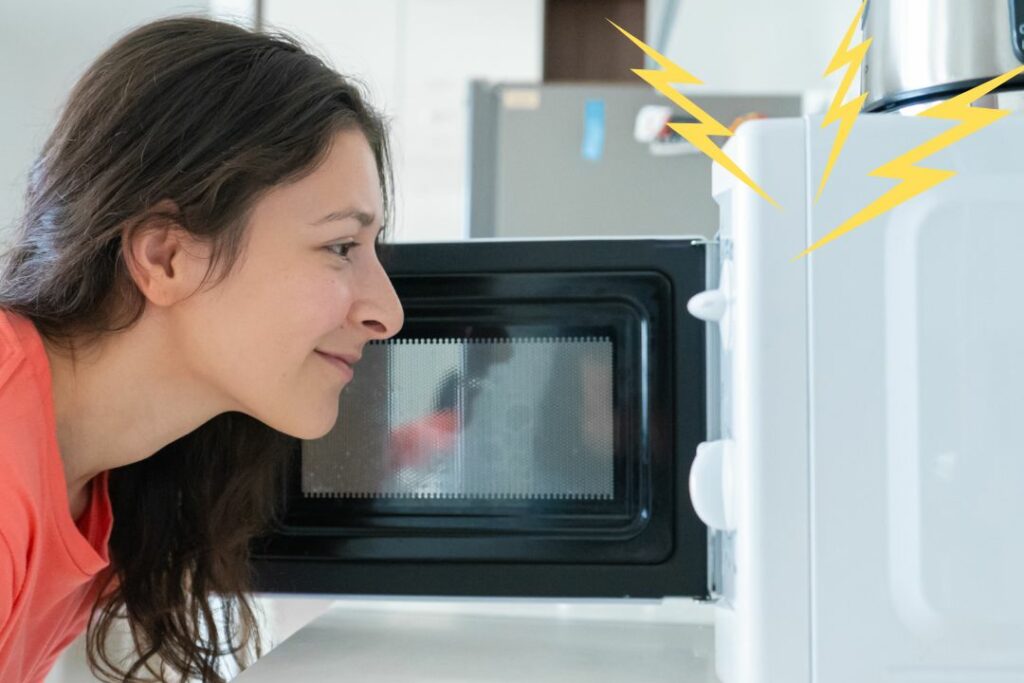Whether you’re building a new home, remodeling the kitchen, or just getting your first microwave, you’ve got a lot of things to think about. One of the most important questions is: how many amps does a microwave use?
That’s right. The last thing I want to do is buy a fancy new microwave, only to find out it trips the breaker every time I use it (or worse). Plus, it’s always nice to know how heavy usage of any appliance will affect your electricity bill.
So, we’re here to help you understand how microwave watts and amps work!
If you happen to have an air fryer, you can also learn more about how many amps an air fryer uses.

What is the Importance of Microwave Amps?
It’s important to know how many amps your microwave uses largely for safety and cost reasons. Plugging your microwave into an outlet that’s not able to support the power draw required can trip your breaker, damage your appliance, your outlet, and even your home!
If your microwave keeps tripping the breaker, review our guide on potential reasons why that’s happening.
You wouldn’t want to ruin your nice new microwave because it runs on a different amperage than the old one.
Thankfully, the only real concern is not going over the maximum load. As long as your microwave amperage is under the circuit limit, you’ll be fine. It doesn’t need to be an exact match. Whew, that takes some of the stress off!
How Many Amps Does a Microwave Use?
| Microwave Wattage | Microwave Voltage (US) | Amps Required |
| 700W | 120V | 5 |
| 800W | 120V | 6.67 |
| 900W | 120V | 7.5 |
| 1000W | 120V | 8.33 |
| 1100W | 120V | 9.17 |
| 1200W | 120V | 10 |
| 1500W | 120V | 12.5 |
| 1800W | 120V | 15 |
The above chart is based on a 120V power supply, as this is the most common in the US. Always make sure to read your owner’s manual, though. If your particular microwave happens to run on 110V power, this will change your calculations slightly.
At the end of the day, a microwave uses amps equivalent to the wattage divided by the voltage. If you need to adjust for a different wattage or voltage, simply follow this formula.
We also dive into how hot a microwave gets in case you were curious!
How Many Amps Does a Microwave Use in the UK?
| Microwave Wattage | Microwave Voltage (UK) | Amps Required |
| 700W | 230V | 3.04 |
| 800W | 230V | 3.48 |
| 900W | 230V | 3.91 |
| 1000W | 230V | 4.35 |
| 1100W | 230V | 4.78 |
| 1200W | 230V | 5.22 |
| 1500W | 230V | 6.52 |
| 1800W | 230V | 7.83 |
Just as I mentioned with the US numbers, be sure to check that you have a 230V unit for certain. While this is standard, there are 220V and 240V options available as well, so you may need to adjust slightly.
Input vs. Output Wattage During Microwave Use
There’s an important distinction between input and output wattage and subsequently the amps which your microwave uses:
- Input wattage refers to the amount of power the microwave draws from the electrical circuit in your home
- Output watts refers to the power level things are cooked at
These two are generally not the same. In fact, my 1,000W output microwave uses 1,800W of input power. You’ll need to read the manual, the sticker on the microwave itself (usually located inside the door), or the manufacturing specs to find both wattages.

The output wattage is important for determining how fast things will cook in your microwave. Input watts are what you want to use as a basis for how many amps your microwave uses.
If you can’t find the input wattage on your microwave for some reason, the average efficiency of wattage output is between 60-70%. Just calculate a 60% increase from the output wattage to get an general estimate of the input wattage you’ll need to determine how many amps your microwave uses.
With all the amps and wattage, what happens if you microwave nothing?
What Size Breaker Do You Need for a Microwave?
The size breaker you need for a microwave is generally 15 or 20 amps.
While, as you can see from the above, a 15 amp breaker is sufficient in many cases. However, it’s important to have “wiggle room” on the breaker it’s assigned to. This is especially true if you plan to have other items on the same breaker, even if it’s only some lights.
In fact, experts recommend at least 20% safety margin on your circuit, meaning that you wouldn’t want to put more than 12 amps on a 15 amp circuit. If you plan to have a 1500W (input) microwave which uses over 12 amps on its own, you would have to have at least a 20 amp circuit.
I’d always recommend choosing a 20 over a 15 (if you have a choice) unless you have a lot of other large-draw appliances that are maxing out your circuit breaker’s capacity. If only a 15 will fit, you’ll be able to make it work with a lower wattage microwave, but don’t plan to load much more on it.
Of course, if you’re adding a new microwave to a current outlet in your home, you won’t get much say. Check your existing breaker for the amps assigned for where your microwave will be used so you know what you’re working with.
Modern kitchens should have at least a couple 20 amp outlets based on current building codes. However, older homes may not necessarily have the same setup. As part of this process, make sure to also figure out what other items draw from the same circuit.
Do it before you even go shopping for a new microwave so you’re prepared!
Do You Need a Dedicated Breaker Just for the Microwave?
While not absolutely necessary, it is recommended to have a dedicated breaker just for the microwave. Microwaves do use less amps than larger appliances, but they spike in power heavily when started and during mode changes.
With additional items on the same circuit, these power spikes could otherwise cause damage to your wiring or appliance. Since this is a pretty normal occurrence with sensor cooking microwaves, I find it’s always better to air on the side of caution.
Learn more about what a sensor cooking microwave is if you’re not familiar.
If you are using a 15 amp circuit, it should definitely be dedicated. On a 20 amp circuit or higher, you have more leeway, but should keep it separate if at all possible. Over-the-stove units are much more likely to have existing dedicated circuits versus a countertop appliance.
As always, if you’re lacking space in your circuit breaker, consult an electrician for assistance before trying to overload existing circuits.
Low Wattage vs High Wattage Microwaves
Now, you may be asking yourself: why don’t I just buy a low wattage microwave and then I’ll probably never have to worry about the amps?
Well, that’s certainly an option! However, while there are pros to this choice, there are also cons.
The biggest favorable factor for low wattage microwaves is the power efficiency. They provide low power usage, which are great for RVs and other home situations where you don’t have many amps available.
Low Wattage Microwaves are More Energy Efficient
Lower watts in a microwave means it costs less to run, due to using less electricity:
| Microwave Watts | Cost to Run 1 Hour |
| 700W | $0.1044 |
| 900W | $0.1343 |
| 1100W | $0.1641 |
This chart is based on the US national average of $0.1492 per KwH.
If you assume that you used your microwave an average of 30 seconds per day over the course of a year you’re looking at a $0.32 for a 700W vs $0.50 for a 1100W microwave.
While that’s not seemingly a huge amount, if you’re regularly cooking with your microwave and using it more than a few seconds a day, the variation in costs will grow.
High Wattage Microwaves Cook Faster Than Low Watt
So, what’s the catch? Well, since low wattage microwaves use less amps and less power, that also means they cook slower. That’s why most household units are around 1000W or greater – simply for the speed and convenience.
Next time you grab a bag of frozen veggies to steam, just check out the time differences:
| Microwave Wattage | Vegetable Cook Time |
| 800W | 7 Minutes |
| 1000W | 6 Minutes |
| 1200W | 5 Minutes |
I happened to have peas and carrots handy, so times may vary for the particular item you’re cooking. However, on average, for every additional 100W of power your microwave has, you can expect to reduce cooking time by about 30 seconds.
Did you ever wonder why ice doesn’t melt in a microwave? It sounds weird, but we assure you that there’s a reason!
Conclusion
You can expect your standard household microwave to use anywhere between 10 and 15 amps, depending on the wattage of the microwave. Knowing this will help you better choose the right appliance that’s suitable for your home or RV.
If you’re building or remodeling a home, make sure to plan to assign adequate amps on your circuit breaker for the type of microwave you’ll want. More powerful microwaves use more amps, but deliver cooked items faster.
At the end of the day, weigh your options, priorities, and needs, and you’ll be able to make the best choice for you!
Depending on where you plan to set your appliance, you may want to know how much a microwave weighs.
- Air Fryer Refried Beans With Canned Pinto Beans - April 24, 2024
- Guava Margarita: Easy Guavarita Drink Recipe! - April 22, 2024
- Air Fryer Avocado Egg Rolls (Cheesecake Factory Copycat) - April 21, 2024

